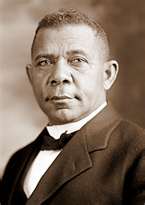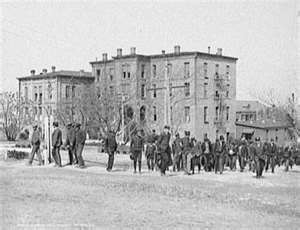The Tuskegee Institute began as a church-owned shanty building and ended up as one of America's most well-known universities.
Washington, a self-made former slave whose passion for learning drove him to become a teacher, made a name for himself at Tuskegee. In the decades that followed, enrollment swelled to several hundred and the college sprawled across 540 acres of land (including a plantation that Washington had bought in 1882). Students attended academic classes as well as more labor-intensive classes such as brickmaking, cabinetmaking, carpentry, and shoemaking. This echoed Washington's doctrine of teaching self-reliance as well as academic learning. Indeed, Tuskegee's students helped construct the new buildings on campus. Well-known for touring the country to give lectures and raise money (including for securing large donations from such famous men as steel tycoon Andrew Carnegie, Standard Oil giants John D. Rockefeller and Henry Rogers, Kodak founder George Eastman, and Sears & Roebuck President Julius Rosenwald), Washington was head of Tuskegee for nearly 40 years. When he died, in 1915, the Institute had a student population of 2,000, a staff of nearly 200, and an endowment of nearly $2 million. 
Washington's legacy extended far beyond the school's borders. Under his leadership, the institute began a rural extension program, so that students who could not afford to live on site could still benefit from its teachings. Tuskegee alumni also spread the word by founding smaller schools throughout the American South, always with an emphasis on training teachers. Among the most prominent alumni was noted inventor George Washington Carver. Tuskegee continued to be a focal point for African-American education after Washington's death, but as the South became more and more industrialized, the needs of students changed, from agricultural-based to more urban-based. Among the additions in the mid-20th Century were a school of veterinary medicine, an architecture program, and many engineering programs. Graduate programs were soon to follow. Tuskegee was also the site for a training program for African-American aviators, many of whom became the famed Tuskegee Airmen. What was Tuskegee Institute is now Tuskegee University, a prominent center for higher learning that offers 35 bachelor's degree programs, 12 master's degree problems, and three doctoral degree programs. |
|
Social Studies for Kids
copyright 2002–2025
David White



 An 1880s agreement between three political leaders — William Foster, Arthur Brooks, and African-American Lewis Adams — resulted in the securing of $2,000 for a new school. The result of this was the Tuskegee Negro Normal Institute, which opened its doors in Tuskegee, Alabama, on July 4, 1881. The funding was enough for one year's pay for staff, including
An 1880s agreement between three political leaders — William Foster, Arthur Brooks, and African-American Lewis Adams — resulted in the securing of $2,000 for a new school. The result of this was the Tuskegee Negro Normal Institute, which opened its doors in Tuskegee, Alabama, on July 4, 1881. The funding was enough for one year's pay for staff, including 
